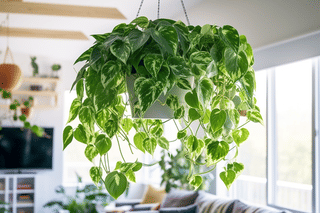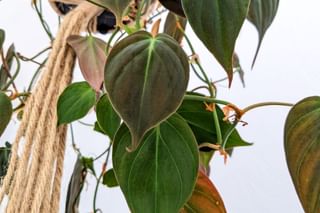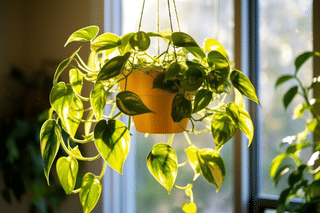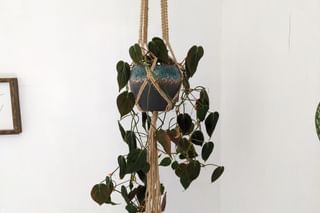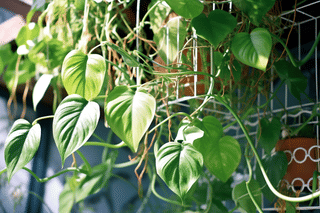Pothos vs Philodendron: Which is Better?
Not sure which you should choose between Pothos or Philodendron (Micans)? Here's a comparison to help you decide. Read on to find out the perfect plant for beginner plant owners.
Do you want a Philodendron? Or was it a Pothos? I think everyone that has plants has gotten the two confused at least once in their life. And for a good reason: they're very similar plants that have roughly the same plant care requirements.
So which one is better? And is there such a thing as a better plant? To find out which plant is better, I'm going to interpret this question like this: Is the Pothos or the Philodendron (Micans) the best plant for beginning plant owners?
In this plant care guide, we're going to look at the different aspects of taking care of either of these plants and see which one is a better choice for beginning plant owners. These are the topics we're going to look at together:
There are a lot of different Philodendrons, so in this guide, I'll use the Philodendron Micans to compare it to a Pothos. There are also many different types of Pothos, but these all have the same plant care requirements. You can use the Scindapsus Golden Pothos as an example.
Let's dive right in and help you make a decision on which plant to choose based on your personal preferences and needs.
Why are Pothos and Philodendron popular plants?
Are you wondering why Pothos and Philodendron plants have become so popular? Well, these plants are easy to take care of and low-maintenance. You just need to water them once a week and they can handle both bright and indirect light. In addition to that, propagating a new plant from a cutting or stem is often fairly straightforward with these species.
Plus, their foliage alone makes them ideal for homeowners who want to add some beauty to their living space, so it's no surprise they've become increasingly popular!
What are the similarities between a Pothos and a Philodendron?
Both Pothos and Philodendrons are popular houseplants that have similar care requirements. They both like bright indirect sunlight, warm temperatures, regular watering (not too much or too little), good soil drainage, and a balanced fertilizer schedule.
Both plants can tolerate lower light as long as you water them less often than they would get if they're growing in a bright spot. These two plants also prefer evenly moist soil during the growing season but should be allowed to dry out more between waterings in winter months when they go dormant.
Both Pothos and Philodendrons can climb up trellises or a moss pole, as they both have aerial roots with which they'll hold onto the object they're climbing.
Lastly, both plants can be propagated easily by stem cuttings placed in a jar of water until they start to grow roots or by planting directly into potting mix with rooting hormone for faster growth.
What are the differences between Pothos and Philodendrons?
People often confuse Pothos and Philodendron because they share similarities in terms of growth habits, leaf shape, and ease of care. I've very often wondered: "Do I have a Philodendron or a Pothos?".
The plants are very similar, but there are some key differences.
- Pothos has shiny, highly variegated leaves, while Philodendron leaves have a matte, velvety, heart-shaped leaves finish and usually have a reddish color on the bottom side of the leaves.
- Pothos leaves are thicker and wider than that of the Philodendron Micans.
- Pothos vines are thicker and can grow much longer without losing too many leaves
- Pothos cuttings root very easily and quickly, so you can propagate it much faster
- Both the Philodendron and Pothos can grow quickly during the spring and summer, but the Pothos puts out new leaves almost weekly during the growing season. The philodendron is a little slower.
As you can see, the plants are both very similar but do have some key differences which could help you to find out if you've got a Pothos on a Philodendron. Explore the leaves and textures and see if you can spot the key signs of both plants. This will help you feel more confident you've properly identified your plant.
Now that you've got an idea of the type of plant that is better for you and your house, let's see how we can take care of each of these plants to help them thrive!
Pothos plant care requirements
Pothos is an extremely sturdy and forgiving houseplant. Despite being relatively easy to care for, it can handle some occasional neglect and still stay lush and full. Are you ready to make your home even brighter with a touch of natural green?
Here are some helpful tips for taking care of your new Pothos plant:
- Lighting : It thrives in bright, indirect light but can tolerate lower light levels. Avoid direct sunlight as it can scorch the leaves.
- Watering : Allow the soil to dry out between waterings. Pothos is susceptible to root rot, so it's important not to overwater.
- Temperature: It prefers temperatures between 60-85℉ (15-29℃).
- Humidity: It's a low-humidity plant, but it benefits from occasional misting to keep the foliage dust-free.
- Fertilizing : It enjoys monthly fertilization during the growing season (spring and summer) with an all-purpose, water-soluble fertilizer.
This list is not a complete list of how you should take care of a Pothos, but these are the most important aspects of taking care of a Pothos. If you follow these tips, your plant will be happy and growing in your home.
If you'd like to know more about taking care of a Pothos, what the best soil is, which common pests it deals with, how you can propagate it, and whether it's safe to have around pets or small children, you can read How to care for a Golden Pothos.
Philodendron plant care requirements
Philodendrons are absolutely stunning plants with velvety, elegant leaves. It's quite easy to care for and overall is quite a low-maintenance houseplant. So if you are looking for a stunning, low-maintenance plant, then look no further than the philodendron!
Caring for this type of plant is simple. Here are some tips to keep your philodendron happy and healthy:
- Lighting : It prefers bright, indirect light, but can also tolerate low light conditions. Don't expose it to direct sunlight, as the sensitive leaves will burn easily.
- Watering: Allow the soil to dry out between watering. Overwatering can lead to root rot.
- Temperature: It prefers temperatures between 65-80℉ (18-26℃).
- Humidity: It benefits from high humidity levels, so periodic misting can be helpful.
- Fertilizing : It responds well to monthly fertilization during the growing season (spring and summer) with an all-purpose, water-soluble fertilizer.
These are the most important aspects to consider when caring for a Philodendron. It's essential to remember that this list is not comprehensive, though. But don't worry, if you follow these tips, your plant will thrive in your home environment, spreading positivity and clean air.
In case you're still curious and want to learn more about taking care of Golden Pothos, check out this helpful article: How to care for a Philodendron. In this plant care guide, we'll cover extra topics, including information on proper soil, common pests, propagation methods, and whether this plant goes well together with pets or little children.
Which is a better plant?
Both Pothos and Philodendron are great plants to have in your collection. Ultimately, the choice comes down to personal preference and what fits well with your home. Let's compare the two and see which one is better for beginners!
Which plant is easier to care for?
Both Pothos and Philodendron are considered easy to care for, but Pothos may have a slight advantage due to its tolerance for neglect. Pothos plants can survive in low light conditions and can go longer without being watered than the Philodendron. This makes them ideal for busy beginners who may not have time to care for a more demanding plant.
Which plant is more tolerant of low light conditions?
The Pothos is more tolerant to low light conditions than Philodendron. Pothos can survive in dimly lit rooms, making it a great addition to any home with limited natural light. Philodendrons prefer bright, indirect light, and may suffer if exposed to direct sunlight or low light conditions for extended periods.
Which plant is more likely to trail or climb?
Both plants have a trailing or climbing growth habit, but Pothos is more likely to spread out more and grow spread further. If you want a plant that stays more compact, the Philodendron is the plant for you. It does trail and vine, but not as quickly and far as a Pothos.
Which plant is more suitable for people with pets?
Both plants are toxic to plants, but a Pothos may be a better option for households with curious pets. Pothos is mildly toxic when ingested, but its toxicity is relatively low compared to other houseplants. Philodendrons are more toxic, and their sap can cause skin irritation or gastrointestinal distress if ingested by pets.
Which plant is more suitable for beginners?
After looking at everything, from the ease of care, propagation possibilities, and even whether the plant goes well with pets or children, the Pothos is the easier plant for beginners. They're both easy and low-maintenance plants, but the Pothos is the easier of the two plants.
Both Pothos and Philodendron are great plants for beginners. They are easy to care for, adaptable to a wide range of growing conditions, and can add an attractive green element to any space. Whether you choose Pothos for its trailing growth habit and low-light tolerance or Philodendron for its amazing color and texture, either choice will provide a low-maintenance, beautiful addition to your home.
Thank you for reading this post! I hope it helps you to keep your plants healthy and beautiful! If you're looking for more guides on specific plants, you can always request a plant guide to get a guide for the plant you have trouble with.
Test your plant care knowledge
Quiz completed!
Want to learn more? Sign up for my newsletter to receive free tips in your inbox!
Sign up now!